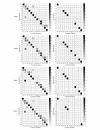A Novel Algorithm for Determining the Contextual Characteristics of Movement Behaviors by Combining Accelerometer Features and Wireless Beacons: Development and Implementation
- PMID: 29678806
- PMCID: PMC5935802
- DOI: 10.2196/mhealth.8516
A Novel Algorithm for Determining the Contextual Characteristics of Movement Behaviors by Combining Accelerometer Features and Wireless Beacons: Development and Implementation
Abstract
Background: Unfortunately, global efforts to promote "how much" physical activity people should be undertaking have been largely unsuccessful. Given the difficulty of achieving a sustained lifestyle behavior change, many scientists are reexamining their approaches. One such approach is to focus on understanding the context of the lifestyle behavior (ie, where, when, and with whom) with a view to identifying promising intervention targets.
Objective: The aim of this study was to develop and implement an innovative algorithm to determine "where" physical activity occurs using proximity sensors coupled with a widely used physical activity monitor.
Methods: A total of 19 Bluetooth beacons were placed in fixed locations within a multilevel, mixed-use building. In addition, 4 receiver-mode sensors were fitted to the wrists of a roving technician who moved throughout the building. The experiment was divided into 4 trials with different walking speeds and dwelling times. The data were analyzed using an original and innovative algorithm based on graph generation and Bayesian filters.
Results: Linear regression models revealed significant correlations between beacon-derived location and ground-truth tracking time, with intraclass correlations suggesting a high goodness of fit (R2=.9780). The algorithm reliably predicted indoor location, and the robustness of the algorithm improved with a longer dwelling time (>100 s; error <10%, R2=.9775). Increased error was observed for transitions between areas due to the device sampling rate, currently limited to 0.1 Hz by the manufacturer.
Conclusions: This study shows that our algorithm can accurately predict the location of an individual within an indoor environment. This novel implementation of "context sensing" will facilitate a wealth of new research questions on promoting healthy behavior change, the optimization of patient care, and efficient health care planning (eg, patient-clinician flow, patient-clinician interaction).
Keywords: activity monitor; algorithm; beacons/proximity; behavior; context; indoor location; physical activity; sedentary behavior; wearable sensor.
©Daniele Magistro, Salvatore Sessa, Andrew P Kingsnorth, Adam Loveday, Alessandro Simeone, Massimiliano Zecca, Dale W Esliger. Originally published in JMIR Mhealth and Uhealth (http://mhealth.jmir.org), 20.04.2018.
Conflict of interest statement
Conflicts of Interest: None declared.
Figures










References
-
- Berrigan D, Hipp JA, Hurvitz PM, James P, Jankowska MM, Kerr J, Laden F, Leonard T, McKinnon RA, Powell-Wiley TM, Tarlov E, Zenk SN, TREC Spatial and Contextual Measures and Modeling Work Group Geospatial and contextual approaches to energy balance and health. Ann GIS. 2015;21(2):157–168. doi: 10.1080/19475683.2015.1019925. http://europepmc.org/abstract/MED/27076868 - DOI - PMC - PubMed
-
- Kirchner TR, Shiffman S. Spatio-temporal determinants of mental health and well-being: advances in geographically-explicit ecological momentary assessment (GEMA) Soc Psychiatry Psychiatr Epidemiol. 2016 Dec;51(9):1211–23. doi: 10.1007/s00127-016-1277-5. http://europepmc.org/abstract/MED/27558710 - DOI - PMC - PubMed
-
- Popay J, Thomas C, Williams G, Bennett S, Gatrell A, Bostock L. A proper place to live: health inequalities, agency and the normative dimensions of space. Soc Sci Med. 2003 Jul;57(1):55–69. - PubMed
-
- Sampson RJ, Morenoff JD, Gannon-Rowley T. Assessing “ neighborhood effects”: Social processes and new directions in research. Annu Rev Sociol. 2002;28:443–478. doi: 10.1146/annurev.soc.28.110601.141114. https://www.annualreviews.org/doi/10.1146/annurev.soc.28.110601.141114 - DOI - DOI
Grants and funding
LinkOut - more resources
Full Text Sources
Other Literature Sources
Molecular Biology Databases

